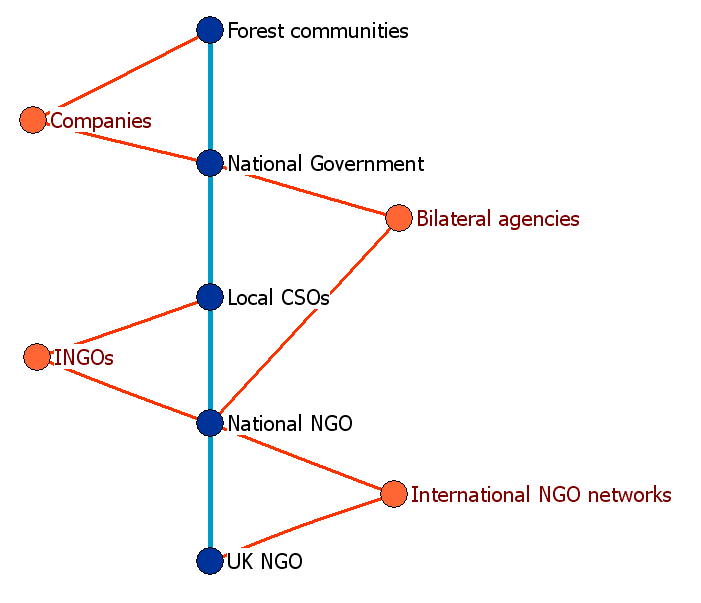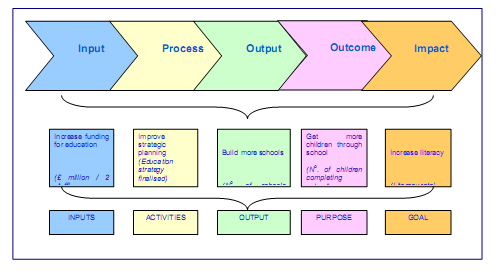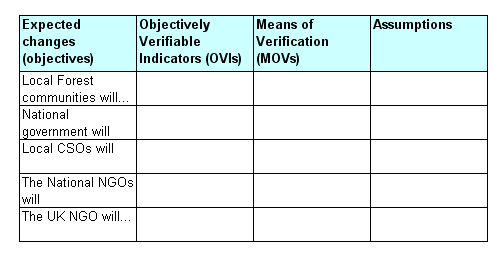- A Social Framework
- The basic idea
- Other differences between the Social and Logical Framework
- Potential complications
- Relation to Outcome Mapping
- Related posts
- Postscripts
1. A Social Framework…
- is a format for describing an expected pathway of influence through a wider network of people, groups or organisations.
- is a Logical Framework re-designed as if people and their relationships mattered
- is a way of summarizing the theory-of-change within a development project, in a form that can be monitored and evaluated. And which can be easily explained to others.
The Social Framework uses the idea of pathways as a bridging concept, which can connect up two very different ways of thinking about development projects. One is the Logical Framework, which provides a very linear view of development, where events happen in a sequence of steps, in one direction. The other is a network view of development, where change can be taking place simultaneously, in many different locations, in the relationships between many different actors.
2. The basic idea
The diagram below shows a number of actors, connected by relationships. It is a simple network diagram, that can be drawn using Excel or social network analysis software. The thick blue line shows a particular pathway through that network that is of interest. What is expected to happen along that pathway can be described in detail using a Social Framework format, which itself is an adaptation of the Logical Framework.

In the table below each of the actors that are on the blue pathway above have been given a row, where the expected changes in that actor’s behavior can be described in detail. The rows of actors are in the same sequence as the chain of actors in the diagram above.
Unlike the Logical Framework, there can be as many rows in the tables as needed, depending on how long the chain of actors is along the pathway. The concept of a chain of relationships has some similarity with the concepts of Value Chains and Supply Chains
3. Other differences between the Social and Logical Framework
The two frameworks appear very similar in that both describe an intended process of change as a series of events taking place across a sequence of rows. Starting at the bottom and going upwards. But there are important differences…
1. Time versus people
In the Logical Framework this vertical dimension represents the flow of time, starting from the present at the bottom and moving to the future at the top. This flow is broken into different stages, represented by each row. The types of events taking place in each of these rows are given different names, typically: Activities, Outputs, Purpose (or outcome) and Goal (or impact). One of the challenges facing users of the Logical Framework is agreeing on where events should be placed within which categories. For example, as activities or outputs, or as outcomes or impacts. Communicating the difference between these categories to non-specialists is even more of a challenge.
In the Social Framework the vertical dimension represents a chain of actors connected by their relationships. Actors can be individuals, organisations or groups, or larger categories of organisations or groups. This choice depends on the scale of the event that needs to be described by the Social Framework. In the Social Framework, the relationships between actors are the means by which change happens. In the Logical Framework change is often described in more abstract terms.
2. Length and direction of influence
Unlike the four rows in the Logical Framework, this chain can be as long or short as is needed. Unlike the Logical Framework causation is likely to work in both directions, up and down the chain of relationships. Actors influence others, and they are also influenced by those others.
3. Using the traditional four columns
Both the Social and Logical Framework involve the use of four columns: a narrative description of the expected change, observable indicators of those changes (OVIs), sources of information on those indicators (MoVs), and assumptions about those changes’ relationships to wider events. The Social Framework design has deliberately kept, but adapted, these elements of the Logical Framework.
The narrative column describes the expected changes in the actors (and their relationships with each other). In the Logical Framework the narrative description is expected to be written in a depersonalised passive voice. In contrast, the actor-centred description in the Social Framework will make it much easier to understand and communicate, the “storyline”.
The MoV column does not simply say where the necessary information (about the expected changes) can be found, but also who will know about these changes. Information needs to be known about by someone to be of any use. Information that exists but is not known to anyone is in effect useless.
The assumptions column describes what other relationships will also be important, because their actions (or inaction) may affect what happens to the actor in each row of the Social Framework. It is important to remember that most Social Frameworks will describe a chain of actors forming a pathway through a wider and more complex network of relationships. For example, in the table above the Assumptions section of the row describing the National NGO should say something about what is expected of their relationships with bilateral agencies and INGOs, which they also have relationships with (shown by the orange links in the diagram).
In a Social Framework there is still a connecting logic between the different rows, as there is in the Logical Framework. However, it is a social logic, with this type of form:
If the National NGO is able to provide technical advice on advocacy strategies to the Local CSOs…
And INGOs continue to fund those Local CSOs for at least three years…
Then the Local CSOs will be able to engage more effectively with the National Government
4. Distributed accountability
One of the potential benefits of the Social Framework is that because there are change objectives for each actor in a pathway, responsibility for the whole chain functioning as intended is distributed amongst all the actors in that pathway. In Logical Framework descriptions of projects, responsibility for success often seems to lay almost solely with one organisation, usually that one closest to the intended beneficiaries. For more on this idea, see my blog posting on distributed accountability in the Katine project in Uganda
5. Potential complications
1. Multiple pathways
In a given project setting there may be more than one pathway. In the diagram above it is quite likely that the National NGO is communicating with the INGOs and with some Bilateral Agencies. The INGOs might be interacting with the Companies as well as Local CSOs. Where these parallel strategies are an important part of the overall project design these auxiliary pathways could be documented in supporting Social Frameworks. Their existence could be referred to in the appropriate Assumptions cell of the central Social Framework.
These relationships can also be shown graphically, using what are called ego-network diagrams. In the above example, the UKNGO is the “ego” in the networks and those others they are in direct contact are the “alters“. The diagram then also shows relevant relationships between the alters. Those alters could then become the ego in another ego-network diagram, showing a wider sub-set of relevant relationships.
2. Multiple views of how someone should change
For any given actor in a chain of relationships there may be different views about how they should change (e.g. they will have their own view, and so will others in immediate relationships with them). How do you reconcile these different views?
If the Social Framework was developed through a participatory process then these differences should be expected to arise during that process and may be resolved. It should be relatively easy to design a Social Framework by participatory means because each stakeholder should be able to see where they fit into the picture, either directly as an actor in the pathway, or indirectly via an Assumptions statement in one or more of the rows.
If the Social Framework was developed to reflect the views of one stakeholder, then their conflicting view of how another actor needs to change may limit their ability to affect change down a given pathway. Or, on discovering that there is a difference in views, they may then try to persuade the other to change in the way they think is needed, and end up being successful. This might be the case with the Local CSOs relationship with National Government, in the simple diagrammatic view shown above.
3. How do you fit short term, medium term and long term changes in Social Framework?
For a given actor there may be different objectives (expected changes) for different time periods. In the short term they may be to be able to do x, in the medium term they may hope to be to do y and in the long term they may want to be to do z. Multiple objectives can be listed, in time order, within each actor’s own row. Similarly with the indicators for each of these in the next column.
Changes in the short versus long term can also be captured by describing multiple pathways, some of which are important in the early stages of a project and some which are more important later on, during and after the project ends.
6. Relation to Outcome Mapping
Both the Social Framework and Outcome Mapping are actor-focused approaches. Louise Shaxson and Ben Clench (2011) have written on how they can be combined. Elsewhere, I have written a one-pager looking at the similarities and differences between Outcome Mapping and Network Models (which Social Frameworks relate to).
If people are using Outcome Mapping but also want something like the Logical Framework to summarise the project intentions (and theory of change) then the following interpretations might be useful:
- In a Social Framework, adjacent actors are each others’ Boundary Partners. Other actors mentioned in the Assumptions column of a given actor might also become their Boundary Partners.
- Outcome Challenges are the expected changes to be described in the first column, for each actor in the Social Framework
- Progress markers could be listed in the Indicators column, for the respective Boundary Partner
- Strategy maps could be described using a network diagram similar to the one used immediately above. Each pathway would need to be highlighted, including their relative importance.
6. For related posts see:
- Social Frameworks: An improvement on the Logical Framework? (2008) The original posting on the idea, on the Rick on the Road blog)
- Network models for representing project settings, plans and outcomes
- The Editor’s concerns (about uses of the Logical Framework) (scroll down the page to the end)
- VisuaLyzer software: for visualising and analysing networks
- Shaxson, L., & Clench, B. (2011). Outcome mapping and social frameworks: Tools for designing, delivering and monitoring policy via distributed partnerships. Delta Partnership.
7. Postscript
1. 2011: I have just been re-reading the new DFID “Guidance on using the revised Logical Framework” On page 9 there is a graphic illustrating an “example of a Results Chain and how it aligns with the logframe format” It interested me because it is a good example of yet another disembodied theory of change, where changes happen but there are no identifiable actors present (except children at Purpose level). This must make the process of monitoring and evaluation more difficult (even in this simple example) and make communication of the project design to others more difficult also.

2. 2011 05 18: Recently in the course of other work I came across this OECD DAC definition of impact: “Positive and negative, primary and secondary long-term effects produced by a development intervention, directly or indirectly, intended or unintended.” Interpreted literally this focus on the long-term could mean that any changes during a project implementation period, commonly three years, would not be considered to be a kind of impact. This could be a bit of a problem in projects aimed at reducing infant or child mortality by improving the quality of health service provision. In the case of maternal and infant health projects, it would be commonly expected that some reductions in the numbers of cases of child and maternal deaths would occur within a project’s lifespan. In fact, the sooner these kinds of changes happened the better.
However, if impact was defined in a different way then kind of this perverse anomaly would not arise. Impact could be defined in terms of social rather than temporal distance, as changes in the lives of people of ultimate concern. In this case, it is mothers and infants, who are at the end of one or more chains of actors, through which aid resources and their effects flow. The Social Framework uses this concept of social distance, whereas the vertical structure of the Logical Framework uses either temporal distance or a conflation of social and temporal distance.
3. 2011 10 28. In February this year Louise Shaxson & Ben Clench, of the Delta Partnership, published a 10 page Working Paper titled “Outcome mapping and social frameworks: tools for designing, delivering and monitoring policy via distributed partnerships” “Partnership working is becoming increasingly important in the policymaking process: no more so than in the UK with the coalition government’s ‘Big Society’ agenda. But the problem is not limited to the UK: the international search for hybrid forms of governance takes on a new urgency as we move towards an era of light touch regulation, small government, and localism. This paper describes two tools which will help policymakers take a rigorous approach to designing, delivering and monitoring policymaking in the face of these complex issues.”
4. 2016 04 16: Since writing the above postings I have had two related ideas. The first is that I have for a long time been ambivalent about what should be described at each level in the Social Framework (as described in the tabular format above) – should it be an actor or a relationship between two actors, or both (i.e. row 1 describes actor A, row 2 describes relationship between actors A & B, row 3 describes actor B, etc). Events described in rows that refer to specific actors (if they are organisations) are essentially happening in a more micro-level set of relationships i.e. within the organisation concerned)
The other idea relates to how you would map the network structure that contains the pathways and surrounding relationships we are interested in. I now think this could be done using something called a greedy algorithm, whereby the exploration of one actor’s ego network would lead on to the exploration of the ego network of the most important actor in the first ego network, and so on. The most important relationship in each ego network (and thus connecting ego networks) would be the causal pathway we would be interested in. In network analysis terms this would be known as a “maximal spanning tree”. Of course, what constituted “most important actor” would have been to be defined in advance of what would in effect be a participatory network mapping exercise.
5. 2020 12 12: Some interesting more recent related developments
-
- Koleros, A., Mulkerne, S., Oldenbeuving, M., & Stein, D. (2020). The Actor-Based Change Framework: A Pragmatic Approach to Developing Program Theory for Interventions in Complex Systems. American Journal of Evaluation, 41(1), 34–53.
- Wood, N. (2020, July 5). Actor-Based Change Frameworks. Rebel with Causation.
.


